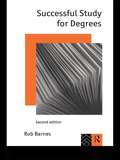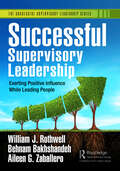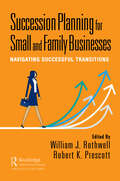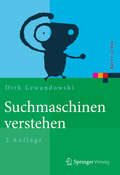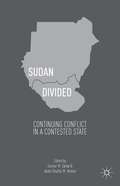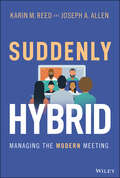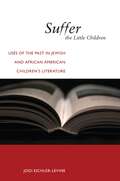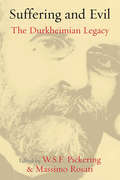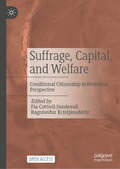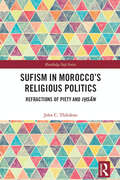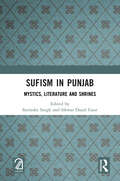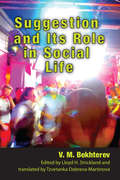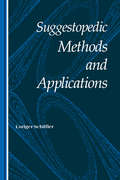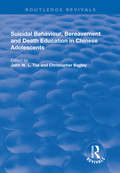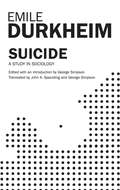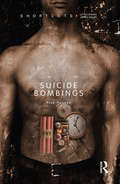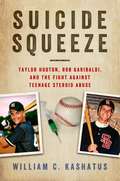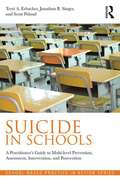- Table View
- List View
Successful Study for Degrees
by Rob BarnesSuccessful Study for Degrees is a practical guide to studying more effectively at first and higher degree levels. Aimed particularly at students looking for more than just a basic study skills book, it blends practical ideas with sound principles, and is structured so that topics such as basic essay writing feed into chapters on dissertation preparation and writing. It uses many examples drawn from interviews conducted with students and lecturers from a range of disciplines. At a time when many arts-based courses are changing in structure, particular attention is given to research-based study, which in many cases is replacing the traditional formal examination. At undergraduate level, the book gives practical guidance on reading, seminars and questioning techniques; at higher degree level, it discusses issues such as validity, reliability and meaning. The book also offers techniques of questioning to promote higher level thinking, including explorations of ways in which argument is constructed and explanations of commonly-used terms such as proposition, premise, assertion and evidence.
Successful Supervisory Leadership: Exerting Positive Influence While Leading People (Successful Supervisory Leadership)
by William J. Rothwell Aileen G. Zaballero Behnam BakhshandehWhy Study Supervision? This book presents two compelling reasons to study supervision and supervisory leadership: Influential Position: Supervisors exert considerable influence on organizational settings. Supervisors have been schooled, developed, and trained for their responsibilities. They can function more effectively than if they learn through informal, sometimes haphazard means. It thus pays to learn about supervision because supervisors can influence how efficiently and effectively their organization functions. Career Path: Many career paths lead to supervision. Supervisors are everywhere. Supervisors are teachers, doctors, accountants, lawyers, plumbers, and electricians. If you aspire to advance within your occupation, you may find that one career path leads to supervision. Preparing for supervisory responsibilities can prepare you for advancement. You may thus have a personal stake – your own future – in learning about what supervisors do and how they do it. In addition, this book: Provides strategies for building solid relationships with team members. Uses positivity as a foundational practice to lead and encourage other employees. Provides guidelines on how to hold employees accountable and set high expectations. Presents strategies to engage, coach, and develop employees by creating a positive environment to influence attitudes and behaviors. Offers various approaches for managing time and increasing productivity.
Successful Supervisory Leadership: Exerting Positive Influence While Leading People (Successful Supervisory Leadership)
by William J. Rothwell Aileen G. Zaballero Behnam BakhshandehWhy Study Supervision?This book presents two compelling reasons to study supervision and supervisory leadership: Influential Position: Supervisors exert considerable influence on organizational settings. Supervisors have been schooled, developed, and trained for their responsibilities. They can function more effectively than if they learn through informal, sometimes haphazard means. It thus pays to learn about supervision because supervisors can influence how efficiently and effectively their organization functions. Career Path: Many career paths lead to supervision. Supervisors are everywhere. Supervisors are teachers, doctors, accountants, lawyers, plumbers, and electricians. If you aspire to advance within your occupation, you may find that one career path leads to supervision. Preparing for supervisory responsibilities can prepare you for advancement. You may thus have a personal stake – your own future – in learning about what supervisors do and how they do it. In addition, this book: Provides strategies for building solid relationships with team members. Uses positivity as a foundational practice to lead and encourage other employees. Provides guidelines on how to hold employees accountable and set high expectations. Presents strategies to engage, coach, and develop employees by creating a positive environment to influence attitudes and behaviors. Offers various approaches for managing time and increasing productivity.
Succession Planning for Small and Family Businesses: Navigating Successful Transitions
by William J. Rothwell and Robert K. PrescottWho will lead your organization into the future? Have you created the systems to properly implement required succession transitions? Have you put the financial tools in place to fund the transition? Do you want a plan that connects with your personal and company core values? When do you include timely planning related to strategy and talent issues? What are the appropriate communication strategies for sharing your plan? What legal issues need consideration related to the strategy, financial, and people aspects of succession? So, what is preventing you from starting this effort tomorrow? Small and family businesses are the bedrock of all businesses. More people are employed by small and family-owned businesses than by all multinational companies combined. Yet the research on small and family businesses is bleak: fewer than one-third of small business owners in the United States can afford to retire. Only 40% of small businesses have a workable disaster plan in case of the sudden death or disability of the owner, and only 42% of small businesses in the United States have a succession plan. Fewer than 11% of family-owned businesses make it to the third generation beyond the founder. Lack of succession planning is the second most common reason for small business failure. Many organizations often wonder where to start and what to do. Succession Planning for Small and Family Businesses: Navigating Successful Transitions presents a comprehensive approach to guiding such efforts. Small and family-owned businesses rarely employ first-rate, well-qualified talent in human resources. More typically, business owners must be jacks-of-all-trades and serve as their own accountants, lawyers, business consultants, marketing experts, and HR wizards. Unfortunately, that does not always work well when business owners embark on planning for retirement or business exits. To help business owners avert problems, this book advises on some of the management, tax and financial, legal, and psychological issues that should be considered when planning retirement or other exits from the business. This comprehensive approach is unique when compared to the books, articles, and other literature that currently exist on the market. This book takes on a bold and integrated approach. Relevant research combined with the rich experiences of the authors connects this thorough, evidence-based approach to action-based approaches for the reader.
Suchmaschinen verstehen (Xpert. Press Ser.)
by Dirk LewandowskiSuchmaschinen sind heute die wichtigsten Werkzeuge, um an Informationen zu gelangen. Wir verwenden Suchmaschinen täglich, meist ohne weiter darüber nachzudenken. Doch wie funktionieren diese Suchwerkzeuge eigentlich genau? Das Buch betrachtet Suchmaschinen aus vier Perspektiven: Technik, Nutzung, Recherche und gesellschaftliche Bedeutung. Es bietet eine klar strukturierte und verständliche Einführung in die Thematik. Zahlreiche Abbildungen erlauben eine schnelle Erfassung des Stoffs.Neben einer ausführlichen Darstellung der in den bekannten Suchmaschinen verwendeten Rankingverfahren wird auch ausführlich auf das Nutzerverhalten eingegangen, das wiederum die Ergebnisdarstellung prägt. Dazu kommen grundlegende Betrachtungen des Suchmaschinenmarktes, der Bedeutung der Suchmaschinenoptimierung und der Rolle der Suchmaschinen als technische Informationsvermittler. Das Buch richtet sich an alle, die mit Suchmaschinen zu tun haben und ein umfassendes Verständnis dieser Suchwerkzeuge erlangen wollen, u.a. Suchmaschinenoptimierer, Entwickler, Informationswissenschaftler, Bibliothekare, Rechercheure in Wissenschaft und Praxis sowie Online-Marketing-Verantwortliche.Für die zweite Auflage wurde der Text vollständig überarbeitet. Neben einem neuen Kapitel zur Suchmaschinenwerbung wurden zahlreiche Abschnitte zu neu aufgekommenen Themen hinzugefügt. Alle Statistiken und Quellen wurden auf den neuesten Stand gebracht.Aus Rezensionen zur ersten Auflage:„Dirk Lewandowski bringt den Fachleuten und Laien näher, was im Hintergrund der Suchmaschine abläuft und wie die Suchergebnisse zustande kommen.“ (Stephan Holländer in Password) „Dirk Lewandowski [...] hat einerseits das Fachwissen, sowohl in die Tiefe zu gehen als auch die Zusammenhänge so verständlich wie möglich zu behandeln. Ein Glücksfall!“ (Jürgen Plieninger in BuB)
Sudan Divided
by Gunnar M. Sørbø Abdel Ghaffar M. AhmedThe 2011 secession of South Sudan spurred hopes for a more just, democratic Sudan, but was followed by new wars and growing unrest. This book examines how the Islamist project has shaped these developments in Sudan, with a particular focus on how divisive policies have driven regional violence as well as the fight against continued marginalization.
Suddenly Hybrid: Managing the Modern Meeting
by Joseph A. Allen Karin M. ReedDiscover the challenges and opportunities of hybrid meetings with this science-based guide from an Emmy-award winning communications expert and renowned organizational psychologist As remote work becomes less of an unusual exception and more of an everyday necessity, hybrid meetings—meetings in which some attendees are physically present while others are virtually present—are becoming the norm. In Suddenly Hybrid: Managing the Modern Meeting, Emmy award-winning communications expert Karin Reed and veteran industrial and organizational psychologist Dr. Joseph A. Allen deliver a practical and actionable framework for attending, hosting, and managing hybrid meetings. The authors draw from their extensive experience in research and business, as well as firsthand stories and up-to-date studies, to offer a guide that’s grounded in science and proven in the real world. You’ll learn about: Best practices based on research from the height of the pandemic and the unexpected paradigm shifts that resulted The challenges and opportunities presented by the trend towards hybrid meetings New research insights gathered from those early in the transition to hybrid meetings, as well as those who are well on their way to implementing a complete framework Perfect for senior business leaders, managers, and even individual contributors, Suddenly Hybrid: Managing the Modern Meeting is required reading for anyone expected to organize, host, or attend virtual or hybrid meetings in their workplace or school.
Suffer the Little Children: Uses of the Past in Jewish and African American Children's Literature (North American Religions)
by Jodi Eichler-LevineExamines classic and contemporary Jewish and African American children’s literatureThrough close readings of selected titles published since 1945, Jodi Eichler-Levine analyzes what is at stake in portraying religious history for young people, particularly when the histories in question are traumatic ones. In the wake of the Holocaust and lynchings, of the Middle Passage and flight from Eastern Europe's pogroms, children’s literature provides diverse and complicated responses to the challenge of representing difficultcollective pasts.In reading the work of various prominent authors, including Maurice Sendak, Julius Lester, Jane Yolen, Sydney Taylor, and Virginia Hamilton, Eichler-Levine changes our understanding of North American religions. She illuminates how narratives of both suffering and nostalgia graft future citizens into ideals of American liberal democracy, and into religious communities that can be understood according to recognizable notions of reading, domestic respectability, and national sacrifice. If children are the idealized recipients of the past, what does it mean to tell tales of suffering to children, and can we imagine modes of memory that move past utopian notions of children as our future? Suffer the Little Children asks readers to alter their worldviews about children’s literature as an “innocent” enterprise, revisiting the genre in a darker and more unsettled light.
Suffering And Evil
by Massimo Rosati W.S.F. PickeringUntil recently the subject of suffering and evil was neglected in the sociological world and was almost absent in Durkheimian studies as well. This book aims to fill the gap, with particular reference to the Durkheimian tradition, by exploring the different meanings that the concepts of evil and suffering have in Durkheim's works, together with the general role they play in his sociology. It also examines the meanings and roles of these concepts in relation to suffering and evil in the work of other authors within the group of the Année sociologique up until the beginning of World War II. Finally, the Durkheimian legacy in its wider aspects is assessed, with particular reference to the importance of the Durkheimian categories in understanding and conceptualizing contemporary forms of evil and suffering.
Suffering and Salvation in Ciudad Juarez
by Nancy Pineda-MadridSince 1993 more than six hundred girls and women have been brutally slain in Ciudad Juárez in internationally condemned violence for which no one has been arrested. Nancy Pineda-Madrid's powerful reflection on this destructive and dehumanizing violence, based on first-hand knowledge of the traumatic situation in Juárez, attempts to understand the cultural, economic, and even religious factors that feed the violence. She detects in the social suffering of the women there a yearning for release, justice, and healing in their quest for salvation through solidarity and community practices that resist rather than acquiesce to the violence.
Suffering and the Intelligence of Love in the Teaching Life: In Light and In Darkness
by Sean Steel Amber HomeniukThis book shares insights drawn from the diverse voices of public school teachers, community outreach education workers, professors, writers, poets, artists, and musicians on suffering in school and the classroom. Teachers speak about their own encounters with and perceptions from suffering using critical-analytic textual works, as well as first-hand personally reflective accounts. By sharing their stories and reflections, the editors and contributors shed light upon the dark areas that often are not addressed in Teacher Training Programs, and that generally remain unaddressed and unacknowledged even as teachers become well-established as professionals in the field of education.
Suffrage, Capital, and Welfare: Conditional Citizenship in Historical Perspective
by Fia Cottrell-Sundevall Ragnheiður KristjánsdóttirThis open access book examines disenfranchisement and voting barriers in ten self-governing and aspiring liberal democracies worldwide, before and after the introduction of so-called universal suffrage. Focusing on economic voting restrictions implemented through constitutional provisions and laws, it explores the various disqualifications that prevent people from voting. The notions of economic independence underpinning these restrictions have built and reinforced societal structures and power relations, particularly concerning class, gender, race, civil status, age, and education. Historically, voting rights have been celebrated as a symbol of inclusivity and equal citizenship. Yet, as contributors in this collection highlight, recent centennial celebrations of universal suffrage often depict it as a distinct milestone, overshadowing the voting restrictions that persisted post women’s suffrage. As democracy now faces new, concerted challenges, there is a compelling reason to revisit and question the narrative of the progression of democratic ideals.
Suffragism and the Great War
by Vivien NewmanJoin Dr Vivien Newman, arm in arm, with some of the formidable women of the pre-First World War suffrage and anti-suffrage movements as, on the declaration of war, they turn their considerable skills, honed over 50 years of active campaigning, to both support of the war and the pursuit of peace.Get to know how these women could bend politicians' wills to their own, challenge and break the many role-norms of contemporary patriarchal society, raise hundreds of thousands of pounds in voluntary contributions and help convince the US public to join the Allied Cause.This book explodes many myths, including the simplistic idea that it was women's war service alone which led to their partial enfranchisement in 1918 as some form of reward from a grateful nation.Vivien Newman reveals a social tapestry which is both complex and infinitely fascinating, one of old friendships broken and new ones formed, shifting alliances and bitter rivalries, of loyalties and even betrayals.
Sufism in Morocco's Religious Politics: Refractions of Piety and Iḥsān (Routledge Sufi Series)
by John C. ThibdeauThis book outlines the role of Sufism in Moroccan politics in the twenty-first century through a comparative study of contemporary Sufi organizations. The author begins his analysis by highlighting the strategies employed by the Moroccan state over the past twenty years, aimed at regulating and producing an authorized ‘Moroccan Islam’ in the kingdom. Despite these policies of spiritual security and spiritual diplomacy, including the state sponsorship of Sufi organizations, the author argues that this has not decreased diversity nor produced a banal interpretation of Islam, but rather given rise to diverse articulations and performances of this religiosity. Through a comparative analysis of three Sufi organizations based on eighteen months of fieldwork – two of which have never before been studied – the author brings into relief the spaces of creative enactment of Sufism as an ethical tradition. Ultimately, it is argued that each Sufi organization reflects a different refraction of iḥsān, a concept emphasising the cultivation of public piety which underpins the Moroccan state’s formulation of Islam. Focused on both theoretical contributions to Islamic studies and topical treatments of geopolitical issues like spiritual diplomacy, the Western Sahara, and Morocco-Algeria, the book spans multiple disciplines, including anthropology, religious studies, sociology, and political science.
Sufism in Punjab: Mystics, Literature and Shrines
by Surinder Singh Ishwar Dayal GaurThis anthology is a collective endeavor of scholars from India and Pakistan devoted to Sufi mystics, literature and shrines with a detailed introduction. The essays explore the methods adopted by the Punjab Sufis to popularize the mystic ideology and praxis in the medieval socio-cultural milieu. These writings also delve into the different genres of Sufi literature, both in the elite and vernacular languages, intending to appreciate the nuances of Punjab Sufism. Apart from the architectural features of the Sufi shrines, the anthology attempts to illumine the organic linkages between these institutions and the Punjabis and, thus, underscore the Sufi non-communitarian devotion as a primary ingredient of the Punjabi cultural fusion. This title is co-published with Aakar Books. Print editions not for sale in South Asia (India, Sri Lanka, Nepal, Bangladesh, Pakistan and Bhutan)
Sugar Plantations in the Formation of Brazilian Society: Bahia, 1550-1835 (Cambridge Latin American Studies #52)
by Alan Knight Stuart B. SchwartzThis study examines the history of the sugar economy and the peculiar development of plantation society over a three hundred year period in Bahia, a major sugar plantation zone and an important terminus of the Atlantic slave trade. Drawing on little-used archival sources, plantations accounts, and notarial records, Professor Schwartz has examined through both quantitative and qualitative methods the various groups that made up plantation society. <p><p> While he devotes much attention to masters and slaves, he views slavery ultimately as part of a larger structure of social and economic relations. The peculiarities of sugar-making and the nature of plantation labour are used throughout the book as keys to an understanding of roles and relationships in plantation society. A comparative perspective is also employed, so that studies of slavery elsewhere in the Americas inform the analysis, while at many points direct comparisons of the Bahian case with other plantation societies are also made.
Suggestion and its Role in Social Life
by V. M. BekhterevVladimir Mikhailovitch Bekhterev was a pioneering Russian neurologist, psychiatrist, and psychologist. A highly esteemed rival of Ivan Pavlov, his achievements in the areas of personality, clinical psychology, and political and social psychology were recognized and acclaimed throughout the world. However, when his version of reflexological doctrine ran afoul of official Soviet ideology in the 1920s his work was banned and his influence suppressed through the dispersal of his many colleagues and disciples. Bekhterev himself died in 1927 under mysterious circumstances. This translation of Suggestion and Its Role in Social Life is a significant instance of intellectual and cultural restoration. It marks a starting point of Bekhterev's lifelong endeavor to relate his clinical observations and philosophy of science to problems of the social world.Bekhterev's investigation reviews and explains the many conflicting positions in the social and scientific thought concerning the nature and power of suggestion. He takes pains to differentiate the process from persuasion and hypnosis, and discusses suggestion and autosuggestion in the waking state, examining their effectiveness on feeling, thought, and behavior. He then discusses the destructive consequences of the process—violent crime, suicide, witchcraft, and devil-possession hysteria— in a wide variety of contexts important in the Russia, Europe and North America of the period.Bekhterev presents a structural model of the mind, including both conscious and unconscious realms, and the phenomena of suggestion without awareness; in doing so he anticipated much present-day work on preconscious influence. Suggestion and Its Role in Social Life is a landmark study in collective psychological research that may lead to revisions in histories of social psychology. It will be read by psychologists, sociologists, and social historians.
Suggestopedic Methods/Applicat
by SchifflerFirst Published in 1992. Routledge is an imprint of Taylor & Francis, an informa company.
Suicidal Behaviour, Bereavement and Death Education in Chinese Adolescents: Hong Kong Studies (Routledge Revivals)
by John W.L. Tse Christopher BagleyThis title was first published in 2002: Why are rates of suicidal behaviour in Chinese adolescents so high? What factors in school, community, family and interpersonal relationships cause this tragedy? Using key new research from leading researchers and social workers with first hand knowledge of these problems in Hong Kong, this enthralling study examines those most at risk and signposts the most effective interventions in therapy and strategic prevention programmes. The result is a highly original and readable account which will be compulsive reading for social workers and academics around the world.
Suicide
by Emile Durkheim John A. Spaulding George SimpsonOne of Durkheim's most important works, serving as a model in social theory.
Suicide Bombings: The Global Rise Of Suicide Bombings (Shortcuts)
by Riaz HassanIn an age when the Western world is preoccupied with worries about weapons of mass destruction in terrorist hands, terrorists across many parts of the globe are using a more basic device as a weapon – life itself. Suicide bombing has become a weapon of choice among terrorist groups because of its lethality and unrivalled ability to cause mayhem and fear, but what is the real driving force behind these attacks? For the first time, Suicide Bombings analyzes concrete data from The Suicide Terrorism Database at Flinders University, Australia, to explain what motivates the perpetrators. The results serve to largely discredit common wisdom that religion and an impressionable personality are the principal causes, and show rather that a cocktail of motivations fuel these attacks which include politics, humiliation, revenge, retaliation, and altruism. Suicide Bombings provides a short but incisive insight into this much publicized form of terrorism, and as such is an informative and engaging resource for students, academics, and indeed anyone with an interest in this topic.
Suicide Squeeze: Taylor Hooton, Rob Garibaldi, and the Fight against Teenage Steroid Abuse
by William C. KashatusAppearance- and performance-enhancing drugs—specifically, anabolic steroids (APEDs)—provide a tempting competitive advantage for amateur baseball players. But this shortcut can exact a fatal cost on talented athletes. In his urgent book Suicide Squeeze, William Kashatus chronicles the experiences of Taylor Hooton and Rob Garibaldi, two promising high school baseball players who abused APEDs in the hopes of attracting professional scouts and Division I recruiters. However, as a result of their steroid abuse, they ended up taking their own lives. In Suicide Squeeze—named for the high-risk play in baseball to steal home—Kashatus identifies the symptoms and dangers of steroid use among teens. Using archival research and interviews with the Hooton and Garibaldi families, he explores the lives and deaths of these two troubled young men, the impact of their suicides on MLB, and the ongoing fight against adolescent APED use by their parents. A passionate appeal to prevent additional senseless deaths by athletes, Suicide Squeeze is an important contribution to debates on youth and sports and on public policy.
Suicide by Self-Immolation: Biopsychosocial and Transcultural Aspects
by César A. Alfonso Prabha S. Chandra Thomas G. SchulzeThis book addresses biopsychosocial and transcultural determinants of suicide by self-immolation, populations at risk throughout the world and prevention strategies specifically designed for young women in fragile environments. Self-immolation, the act of burning oneself as a means of suicide, is rare in high-income countries, and is usually a symbolic display of political protest among men that generally receives international media coverage. In contrast, in low- and-middle-income countries it is highly prevalent, primarily affects women, and may be one of the most common suicide methods in regions of Central and South Asia and parts of Africa. Psychiatric conditions, like adjustment disorders, traumatic stress disorders, and major depression, and family dynamics that include intimate partner violence, forced marriages, the threat of honor killings, and interpersonal family conflicts in a cultural context of war-related life events, poverty, forced migration and ethnic conflicts are important contributing factors. Written by over 40 academic psychiatrists from all continents, sociologists, and historians, the book covers topics such as region-specific cultural and historical factors associated with suicide; the role of religion and belief systems; marginalization, oppression, retraumatization and suicide risk; countertransference aspects of working in burn centers; responsible reporting and the media; and suicide prevention strategies to protect those at risk.
Suicide in Modern Literature: Social Causes, Existential Reasons, and Prevention Strategies
by Josefa Ros VelascoThis book analyzes the social and contextual causes of suicide, the existential and philosophical reasons for committing suicide, and the prevention strategies that modern fictional literature places at our disposal. They go through the review of Modern fictional literature, in the American and European geographical framework, following the rationales that modern literature based on fiction can serve the purpose of understanding better the phenomenon of suicide, its most inaccessible impulses, and that has the potential to prevent suicide.From the turn of the 20th century to the present, debates over the meaning of suicide became a privileged site for efforts to discover the reasons why people commit suicide and how to prevent this behavior. Since the French sociologist and philosopher Émile Durkheim published his study Suicide: A Study in Sociology in 1897, a reframing of suicide took place, giving rise to a flourishing group of researchers and authors devoting their efforts to understand better the causes of suicide and to the formation of suicide prevention organizations. A century later, we still keep on trying to reach such an understanding of suicide, the nature, and nuances of its modern conceptualization, to prevent suicidal behaviors.The question of what suicide means in and for modernity is not an overcome one. Suicide is an act that touches all of our lives and engages with the incomprehensible and unsayable. Since the turn of the millennium, a fierce debate about the state’s role in assisted suicide has been adopted. Beyond the discussion as to whether physicians should assist in the suicide of patients with unbearable and hopeless suffering, the scope of the suicidal agency is much broader concerning general people wanting to die.
Suicide in Schools: A Practitioner's Guide to Multi-level Prevention, Assessment, Intervention, and Postvention (School-based practice in action series)
by Scott Poland; Jonathan B. Singer; Terri A. ErbacherThe authors include detailed case examples, innovative approaches for professional practice, usable handouts, and internet resources on the best practice approaches to effectively work with youth who are experiencing a suicidal crisis as well as those students, families, school staff, and community members who have suffered the loss of a loved one to suicide.
